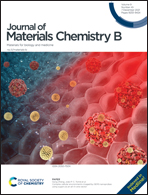Fluorescently conjugated annular fibrin clot for multiplexed real-time digestion analysis†
Abstract
Impaired fibrinolysis has long been considered as a risk factor for venous thromboembolism. Fibrin clots formed at physiological concentrations are promising substrates for monitoring fibrinolytic performance as they offer clot microstructures resembling in vivo. Here we introduce a fluorescently labeled fibrin clot lysis assay which leverages a unique annular clot geometry assayed using a microplate reader. A physiologically relevant fibrin clotting formulation was explored to achieve high assay sensitivity while minimizing labeling impact as fluorescence isothiocyanate (FITC)-fibrin(ogen) conjugations significantly affect both fibrin polymerization and fibrinolysis. Clot characteristics were examined using thromboelastography (TEG), turbidity, scanning electron microscopy, and confocal microscopy. Sample fibrinolytic activities at varying plasmin, plasminogen, and tissue plasminogen activator (tPA) concentrations were assessed in the present study and results were compared to an S2251 chromogenic assay. The optimized physiologically relevant clot substrate showed minimal reporter-conjugation impact with nearly physiological clot properties. The assay demonstrated good reproducibility, wide working range, kinetic read ability, low limit of detection, and the capability to distinguish fibrin binding-related lytic performance. In combination with its ease for multiplexing, it also has applications as a convenient platform for assessing patient fibrinolytic potential and screening thrombolytic drug activities in personalized medical applications.



 Please wait while we load your content...
Please wait while we load your content...